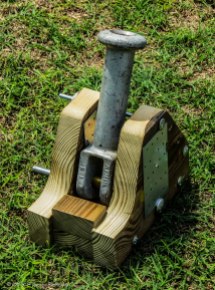Almost done! The table is built, the anvils have been moved. Next anchor them down. Next time I update you I’ll be ready to hit the forge and start hammering! Stay tuned!
On Exhibit: Railroad Hooks to Custom-forged Knives and Hand-carved Irish Cudgel
Coehorn Mortars in all sizes
A bit of history -A Coehorn was a portable mortar developed in the Netherlands by Menno van Coehoorn in 1674 and in use from the seventeenth to the mid nineteenth centuries. Unlike larger, heavier mortars, the coehorn was designed to be movable by as few as four men. By the time of the American Civil War, it was in service with both armies in twelve (4.62″) and twenty-four pound varieties.
Unlike most other contemporary mortars, the coehorn fired a powder-filled, time-fused shell at a relatively short range. Range could be altered by adding to or reducing the amount of powder loaded behind the shell. Its usually small powder charge and slow muzzle velocity meant that the shell’s high, arching flight could be easily observed from ground level.
Small replicas of Coehorn mortars made of brass and steel with wooden bases. Size of barrels range from 6 to 10 inches. See more images on Specialty Knives page!
File Knives & A Viking Seax!
What Kinds of Oysters Can You Find In Your Neck of the Woods
A person used to be able to simply order a dozen oysters. No more. Raw bars present patrons with lists of dozens of oysters to chose from. Wellfleets are prized in New England, New Yorkers love their Blue Points, and Kumamotos rule on the West Coast. Yet there are just five species of oysters harvested in the U.S., all other differences come from where they live, the water they filter, and how they’re handled.
Their taste, in the end, is local.
Whether you’re headed to a raw bar or to the market, this guide will help you decipher the world of oyster labeling and oyster types. Looking to prepare them at home? See How to Shuck Oysters and Sauces for Oysters on the Half-Shell. Or, perhaps you’s prefer to cook them? Grilled Oysters are a favorite of mine.

1. Crassostrea gigas – Pacific Oysters
Pacific oysters are small and sweet and the world’s most cultivated oyster. They are growing in popularity in both Europe and the West Coast, where they are starting to over-run the native Olympia (below). Pacific oysters used to be used to describe all small Pacific oysters like Kumamotos and Miyagis. Kumamotos, however, were found to be their own species (below). Pacifics have a distinctly more fluted, sharply pointed shell than Atlantics or European flats.
Today, Pacifics are usually named after where they are grown, such as Totten Inlet and Fanny Bay, but some are trade names such as the justly well-known Sweetwater oyster from Hog Island Oyster Company.

2. Crassostrea sikamea – Kumamoto Oysters
Kumamotos are small, sweet, almost nutty oysters characterized by their deep, almost bowl-shaped shell. Like Pacifics, they have deeply fluted, sharp, pointy shells. They spawn later and in warmer water than other oysters, so they remain firm and sweet well into summer months. Kumamotos are widely cultivated in Japan and the West Coast. The name Kumamoto is so valued that Kumamotos are always labeled as such, although some places will also specify where they are from.
Kumamotos used to be lumped in with Pacific oysters, but it ends up they are their very own species.

3. Crassostrea virginicas – Atlantic Oysters (Bluepoints, Wellfleets, and More)
Many people are shocked to learn that Bluepoints and Wellfleets, Malpeques and Beausoleils are all Crassostrea virginicas, as are some 85% of oysters harvested in the U.S. (including most of those in the Gulf of Mexico).
True bluepoints are raised in Long Island’s Great South Bay where they were first found. Today “bluepoint oyster” is often used as a general term for any Atlantic oyster served on the half-shell (i.e. “New Jersey bluepoints” and “Virginia bluepoints”), which, if you know they are all the same species anyway, is amusingly absurd.
Wellfleet oysters are grown in Wellfleet Harbor in the northeastern part of Cape Cod. Enthusiasts correctly detect many differences between oysters grown in different parts of the harbor.






















